Financial Accounting Report: Technology Enterprises and AASB 138
VerifiedAdded on 2022/11/26
|8
|2453
|269
Report
AI Summary
This financial accounting report examines the treatment of intangible assets and related expenses within Technology Enterprises Limited, focusing on AASB 138/IAS 38. The report begins with an executive summary and table of contents, then defines intangible assets and their recognition and measurement, including research costs and asset development. The report then analyzes the financial statements of Technology Enterprises Limited using net present value for valuation and addresses the minimization of financial statement comparability due to AASB 138 regulations. A detailed explanation of AASB 138/IAS 38 is provided, covering the standard's guidelines for intangible assets. The conclusion recommends using the present value method for project estimation and adherence to AASB 138 standards. The report also emphasizes the importance of comparability in financial statements and the impact of changes in asset measurement. The report references relevant academic sources to support its findings.
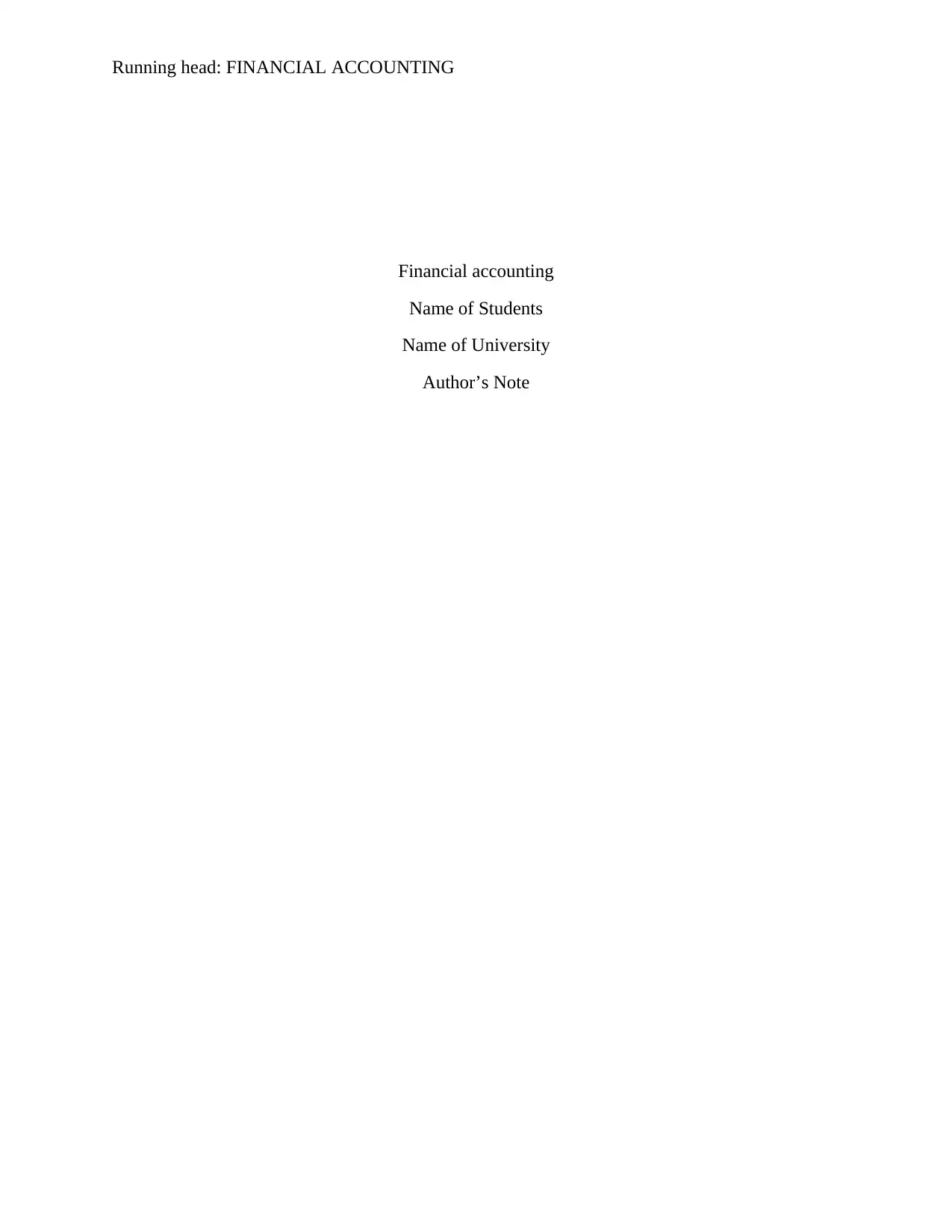
Running head: FINANCIAL ACCOUNTING
Financial accounting
Name of Students
Name of University
Author’s Note
Financial accounting
Name of Students
Name of University
Author’s Note
Paraphrase This Document
Need a fresh take? Get an instant paraphrase of this document with our AI Paraphraser
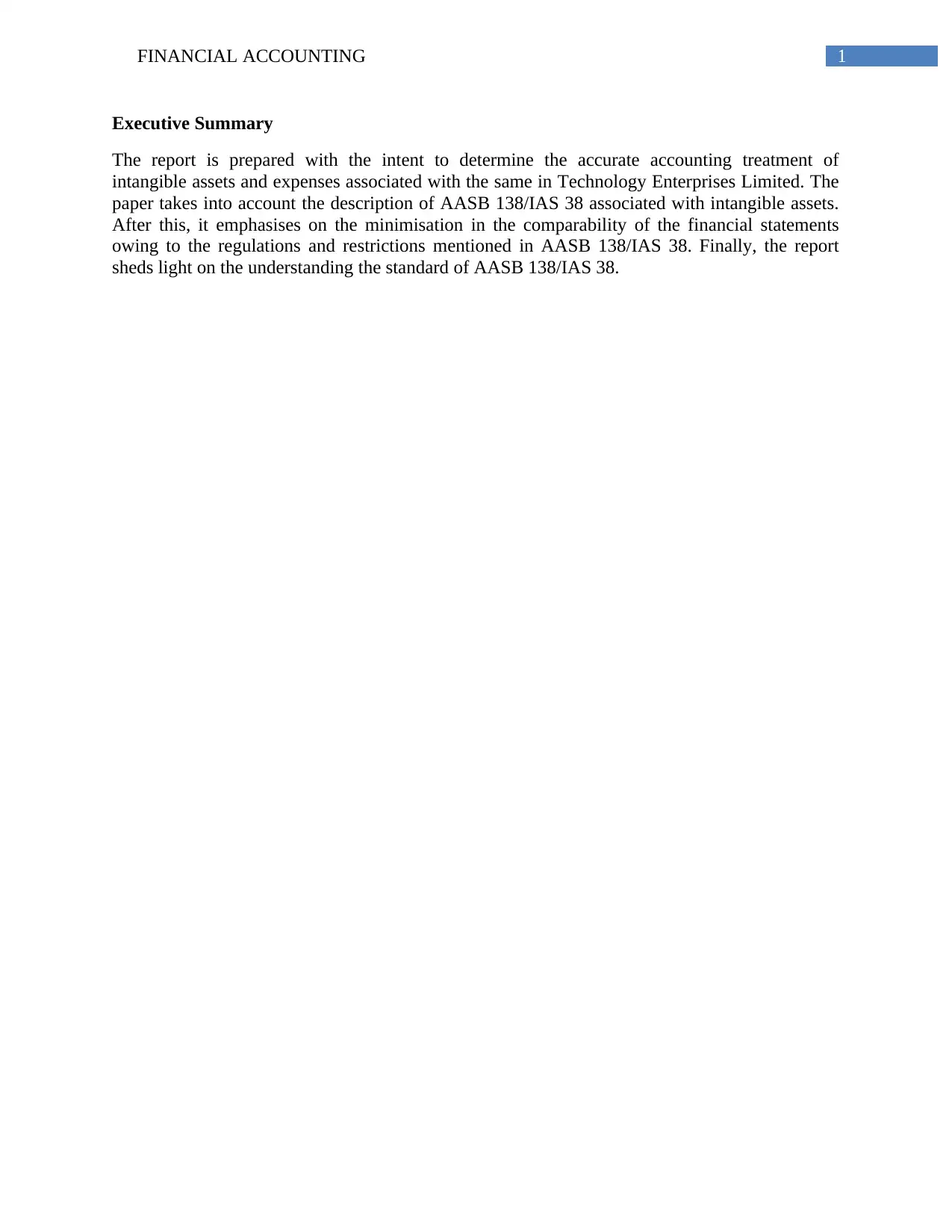
1FINANCIAL ACCOUNTING
Executive Summary
The report is prepared with the intent to determine the accurate accounting treatment of
intangible assets and expenses associated with the same in Technology Enterprises Limited. The
paper takes into account the description of AASB 138/IAS 38 associated with intangible assets.
After this, it emphasises on the minimisation in the comparability of the financial statements
owing to the regulations and restrictions mentioned in AASB 138/IAS 38. Finally, the report
sheds light on the understanding the standard of AASB 138/IAS 38.
Executive Summary
The report is prepared with the intent to determine the accurate accounting treatment of
intangible assets and expenses associated with the same in Technology Enterprises Limited. The
paper takes into account the description of AASB 138/IAS 38 associated with intangible assets.
After this, it emphasises on the minimisation in the comparability of the financial statements
owing to the regulations and restrictions mentioned in AASB 138/IAS 38. Finally, the report
sheds light on the understanding the standard of AASB 138/IAS 38.
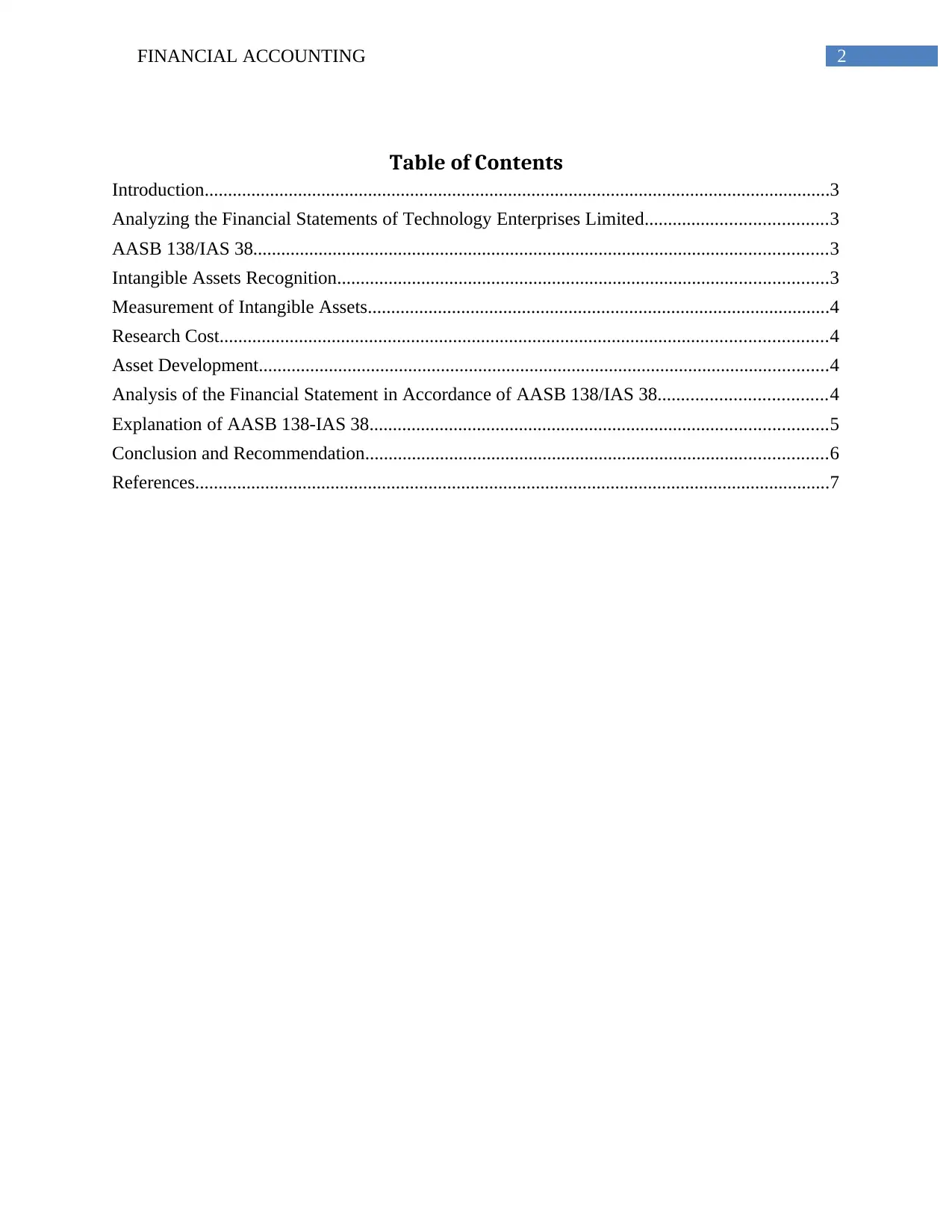
2FINANCIAL ACCOUNTING
Table of Contents
Introduction......................................................................................................................................3
Analyzing the Financial Statements of Technology Enterprises Limited.......................................3
AASB 138/IAS 38...........................................................................................................................3
Intangible Assets Recognition.........................................................................................................3
Measurement of Intangible Assets...................................................................................................4
Research Cost..................................................................................................................................4
Asset Development..........................................................................................................................4
Analysis of the Financial Statement in Accordance of AASB 138/IAS 38....................................4
Explanation of AASB 138-IAS 38..................................................................................................5
Conclusion and Recommendation...................................................................................................6
References........................................................................................................................................7
Table of Contents
Introduction......................................................................................................................................3
Analyzing the Financial Statements of Technology Enterprises Limited.......................................3
AASB 138/IAS 38...........................................................................................................................3
Intangible Assets Recognition.........................................................................................................3
Measurement of Intangible Assets...................................................................................................4
Research Cost..................................................................................................................................4
Asset Development..........................................................................................................................4
Analysis of the Financial Statement in Accordance of AASB 138/IAS 38....................................4
Explanation of AASB 138-IAS 38..................................................................................................5
Conclusion and Recommendation...................................................................................................6
References........................................................................................................................................7
⊘ This is a preview!⊘
Do you want full access?
Subscribe today to unlock all pages.

Trusted by 1+ million students worldwide
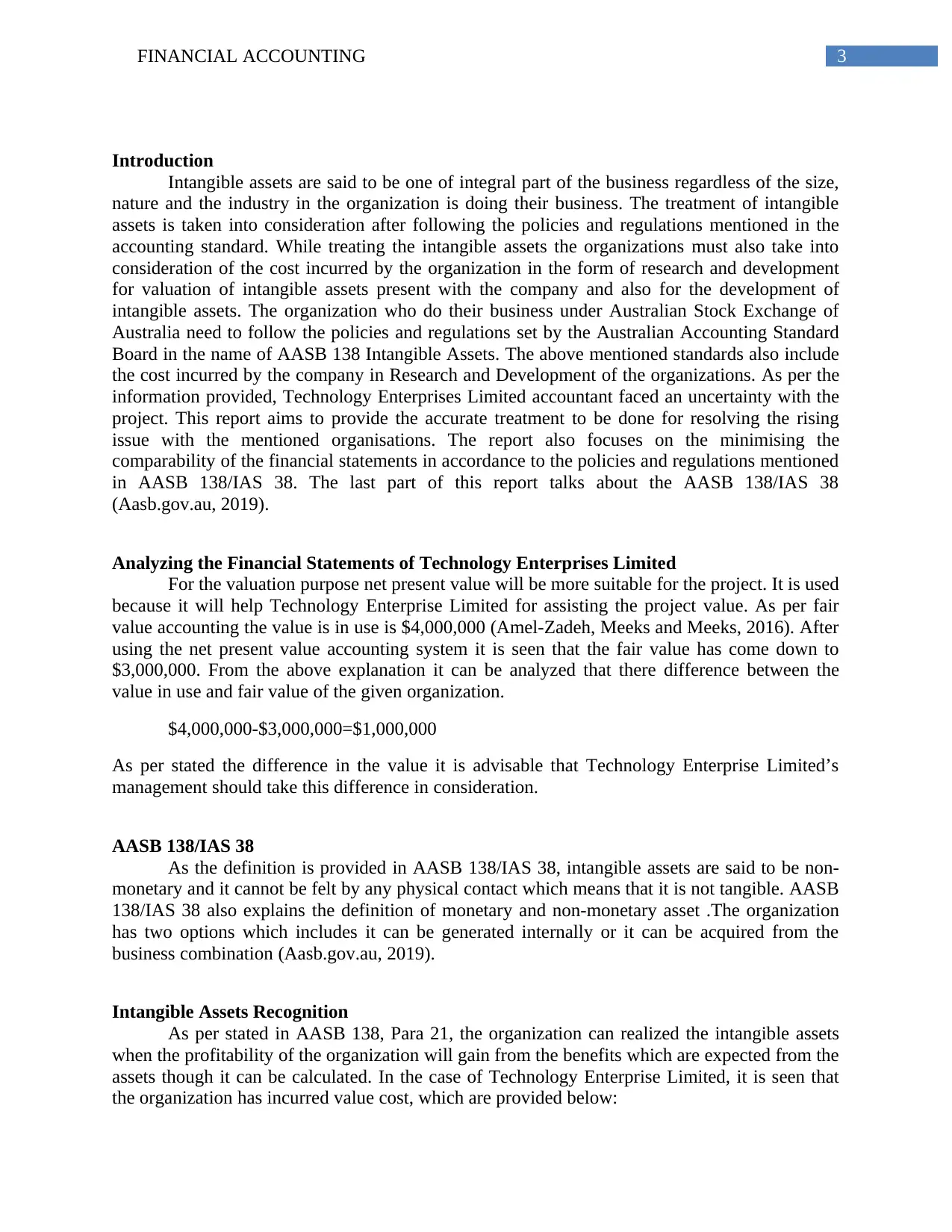
3FINANCIAL ACCOUNTING
Introduction
Intangible assets are said to be one of integral part of the business regardless of the size,
nature and the industry in the organization is doing their business. The treatment of intangible
assets is taken into consideration after following the policies and regulations mentioned in the
accounting standard. While treating the intangible assets the organizations must also take into
consideration of the cost incurred by the organization in the form of research and development
for valuation of intangible assets present with the company and also for the development of
intangible assets. The organization who do their business under Australian Stock Exchange of
Australia need to follow the policies and regulations set by the Australian Accounting Standard
Board in the name of AASB 138 Intangible Assets. The above mentioned standards also include
the cost incurred by the company in Research and Development of the organizations. As per the
information provided, Technology Enterprises Limited accountant faced an uncertainty with the
project. This report aims to provide the accurate treatment to be done for resolving the rising
issue with the mentioned organisations. The report also focuses on the minimising the
comparability of the financial statements in accordance to the policies and regulations mentioned
in AASB 138/IAS 38. The last part of this report talks about the AASB 138/IAS 38
(Aasb.gov.au, 2019).
Analyzing the Financial Statements of Technology Enterprises Limited
For the valuation purpose net present value will be more suitable for the project. It is used
because it will help Technology Enterprise Limited for assisting the project value. As per fair
value accounting the value is in use is $4,000,000 (Amel-Zadeh, Meeks and Meeks, 2016). After
using the net present value accounting system it is seen that the fair value has come down to
$3,000,000. From the above explanation it can be analyzed that there difference between the
value in use and fair value of the given organization.
$4,000,000-$3,000,000=$1,000,000
As per stated the difference in the value it is advisable that Technology Enterprise Limited’s
management should take this difference in consideration.
AASB 138/IAS 38
As the definition is provided in AASB 138/IAS 38, intangible assets are said to be non-
monetary and it cannot be felt by any physical contact which means that it is not tangible. AASB
138/IAS 38 also explains the definition of monetary and non-monetary asset .The organization
has two options which includes it can be generated internally or it can be acquired from the
business combination (Aasb.gov.au, 2019).
Intangible Assets Recognition
As per stated in AASB 138, Para 21, the organization can realized the intangible assets
when the profitability of the organization will gain from the benefits which are expected from the
assets though it can be calculated. In the case of Technology Enterprise Limited, it is seen that
the organization has incurred value cost, which are provided below:
Introduction
Intangible assets are said to be one of integral part of the business regardless of the size,
nature and the industry in the organization is doing their business. The treatment of intangible
assets is taken into consideration after following the policies and regulations mentioned in the
accounting standard. While treating the intangible assets the organizations must also take into
consideration of the cost incurred by the organization in the form of research and development
for valuation of intangible assets present with the company and also for the development of
intangible assets. The organization who do their business under Australian Stock Exchange of
Australia need to follow the policies and regulations set by the Australian Accounting Standard
Board in the name of AASB 138 Intangible Assets. The above mentioned standards also include
the cost incurred by the company in Research and Development of the organizations. As per the
information provided, Technology Enterprises Limited accountant faced an uncertainty with the
project. This report aims to provide the accurate treatment to be done for resolving the rising
issue with the mentioned organisations. The report also focuses on the minimising the
comparability of the financial statements in accordance to the policies and regulations mentioned
in AASB 138/IAS 38. The last part of this report talks about the AASB 138/IAS 38
(Aasb.gov.au, 2019).
Analyzing the Financial Statements of Technology Enterprises Limited
For the valuation purpose net present value will be more suitable for the project. It is used
because it will help Technology Enterprise Limited for assisting the project value. As per fair
value accounting the value is in use is $4,000,000 (Amel-Zadeh, Meeks and Meeks, 2016). After
using the net present value accounting system it is seen that the fair value has come down to
$3,000,000. From the above explanation it can be analyzed that there difference between the
value in use and fair value of the given organization.
$4,000,000-$3,000,000=$1,000,000
As per stated the difference in the value it is advisable that Technology Enterprise Limited’s
management should take this difference in consideration.
AASB 138/IAS 38
As the definition is provided in AASB 138/IAS 38, intangible assets are said to be non-
monetary and it cannot be felt by any physical contact which means that it is not tangible. AASB
138/IAS 38 also explains the definition of monetary and non-monetary asset .The organization
has two options which includes it can be generated internally or it can be acquired from the
business combination (Aasb.gov.au, 2019).
Intangible Assets Recognition
As per stated in AASB 138, Para 21, the organization can realized the intangible assets
when the profitability of the organization will gain from the benefits which are expected from the
assets though it can be calculated. In the case of Technology Enterprise Limited, it is seen that
the organization has incurred value cost, which are provided below:
Paraphrase This Document
Need a fresh take? Get an instant paraphrase of this document with our AI Paraphraser
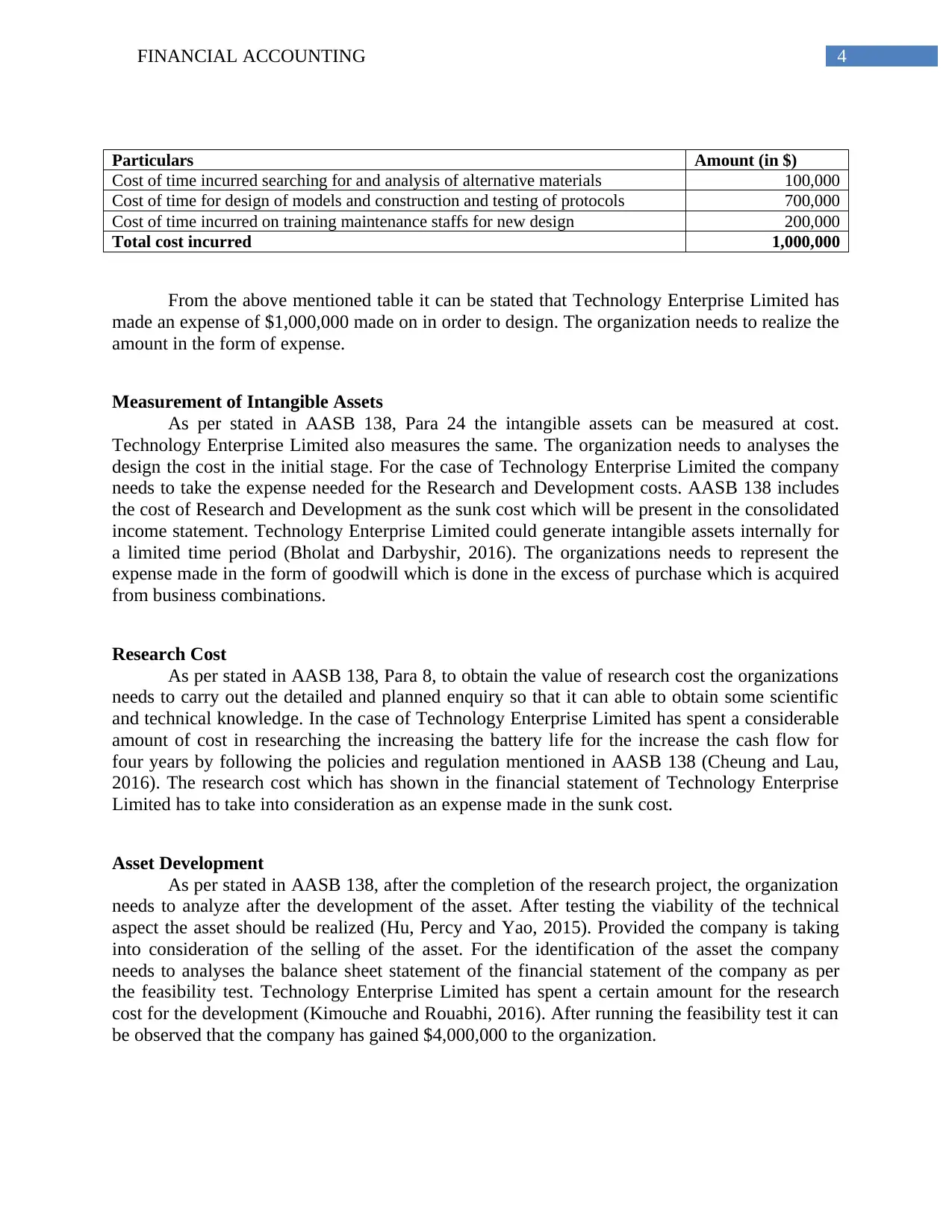
4FINANCIAL ACCOUNTING
Particulars Amount (in $)
Cost of time incurred searching for and analysis of alternative materials 100,000
Cost of time for design of models and construction and testing of protocols 700,000
Cost of time incurred on training maintenance staffs for new design 200,000
Total cost incurred 1,000,000
From the above mentioned table it can be stated that Technology Enterprise Limited has
made an expense of $1,000,000 made on in order to design. The organization needs to realize the
amount in the form of expense.
Measurement of Intangible Assets
As per stated in AASB 138, Para 24 the intangible assets can be measured at cost.
Technology Enterprise Limited also measures the same. The organization needs to analyses the
design the cost in the initial stage. For the case of Technology Enterprise Limited the company
needs to take the expense needed for the Research and Development costs. AASB 138 includes
the cost of Research and Development as the sunk cost which will be present in the consolidated
income statement. Technology Enterprise Limited could generate intangible assets internally for
a limited time period (Bholat and Darbyshir, 2016). The organizations needs to represent the
expense made in the form of goodwill which is done in the excess of purchase which is acquired
from business combinations.
Research Cost
As per stated in AASB 138, Para 8, to obtain the value of research cost the organizations
needs to carry out the detailed and planned enquiry so that it can able to obtain some scientific
and technical knowledge. In the case of Technology Enterprise Limited has spent a considerable
amount of cost in researching the increasing the battery life for the increase the cash flow for
four years by following the policies and regulation mentioned in AASB 138 (Cheung and Lau,
2016). The research cost which has shown in the financial statement of Technology Enterprise
Limited has to take into consideration as an expense made in the sunk cost.
Asset Development
As per stated in AASB 138, after the completion of the research project, the organization
needs to analyze after the development of the asset. After testing the viability of the technical
aspect the asset should be realized (Hu, Percy and Yao, 2015). Provided the company is taking
into consideration of the selling of the asset. For the identification of the asset the company
needs to analyses the balance sheet statement of the financial statement of the company as per
the feasibility test. Technology Enterprise Limited has spent a certain amount for the research
cost for the development (Kimouche and Rouabhi, 2016). After running the feasibility test it can
be observed that the company has gained $4,000,000 to the organization.
Particulars Amount (in $)
Cost of time incurred searching for and analysis of alternative materials 100,000
Cost of time for design of models and construction and testing of protocols 700,000
Cost of time incurred on training maintenance staffs for new design 200,000
Total cost incurred 1,000,000
From the above mentioned table it can be stated that Technology Enterprise Limited has
made an expense of $1,000,000 made on in order to design. The organization needs to realize the
amount in the form of expense.
Measurement of Intangible Assets
As per stated in AASB 138, Para 24 the intangible assets can be measured at cost.
Technology Enterprise Limited also measures the same. The organization needs to analyses the
design the cost in the initial stage. For the case of Technology Enterprise Limited the company
needs to take the expense needed for the Research and Development costs. AASB 138 includes
the cost of Research and Development as the sunk cost which will be present in the consolidated
income statement. Technology Enterprise Limited could generate intangible assets internally for
a limited time period (Bholat and Darbyshir, 2016). The organizations needs to represent the
expense made in the form of goodwill which is done in the excess of purchase which is acquired
from business combinations.
Research Cost
As per stated in AASB 138, Para 8, to obtain the value of research cost the organizations
needs to carry out the detailed and planned enquiry so that it can able to obtain some scientific
and technical knowledge. In the case of Technology Enterprise Limited has spent a considerable
amount of cost in researching the increasing the battery life for the increase the cash flow for
four years by following the policies and regulation mentioned in AASB 138 (Cheung and Lau,
2016). The research cost which has shown in the financial statement of Technology Enterprise
Limited has to take into consideration as an expense made in the sunk cost.
Asset Development
As per stated in AASB 138, after the completion of the research project, the organization
needs to analyze after the development of the asset. After testing the viability of the technical
aspect the asset should be realized (Hu, Percy and Yao, 2015). Provided the company is taking
into consideration of the selling of the asset. For the identification of the asset the company
needs to analyses the balance sheet statement of the financial statement of the company as per
the feasibility test. Technology Enterprise Limited has spent a certain amount for the research
cost for the development (Kimouche and Rouabhi, 2016). After running the feasibility test it can
be observed that the company has gained $4,000,000 to the organization.
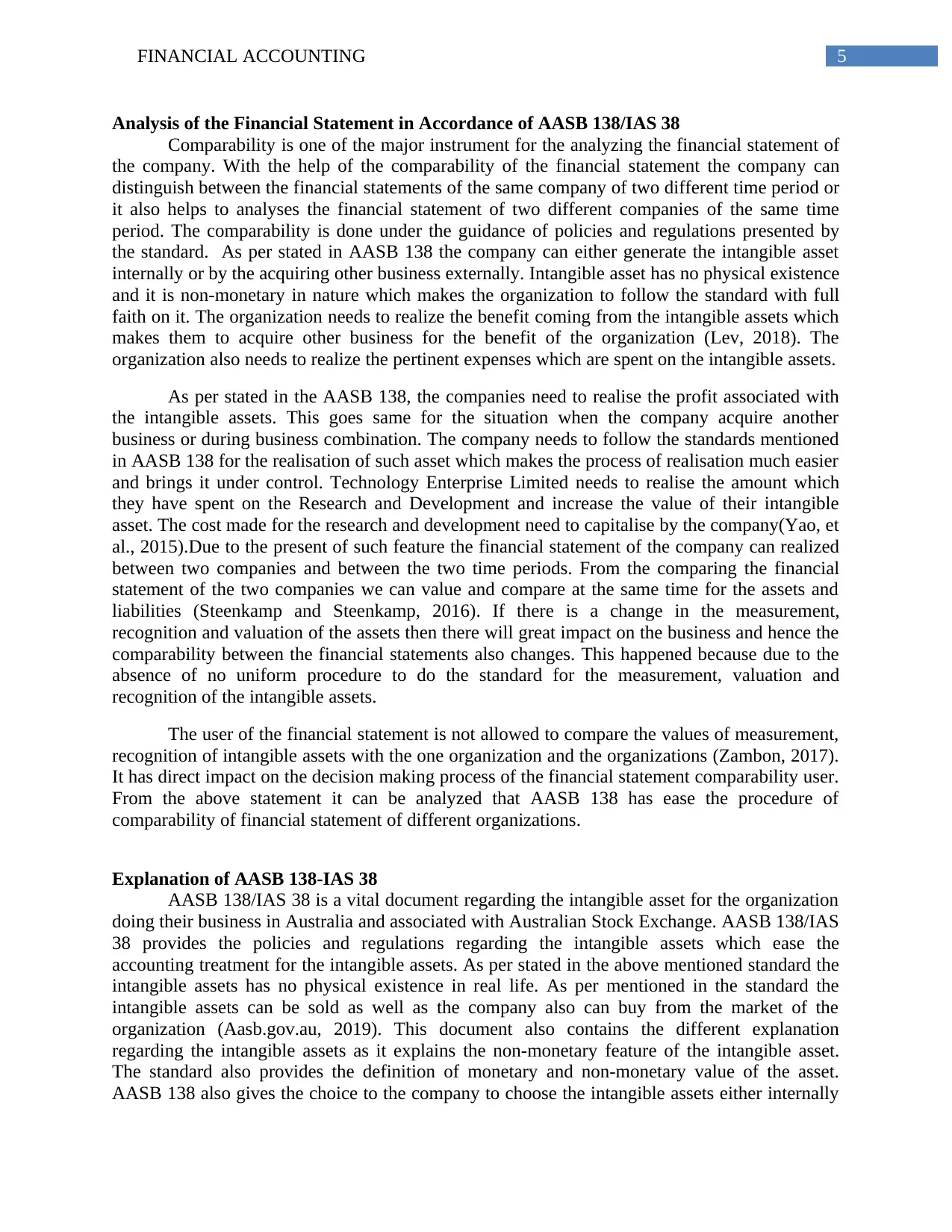
5FINANCIAL ACCOUNTING
Analysis of the Financial Statement in Accordance of AASB 138/IAS 38
Comparability is one of the major instrument for the analyzing the financial statement of
the company. With the help of the comparability of the financial statement the company can
distinguish between the financial statements of the same company of two different time period or
it also helps to analyses the financial statement of two different companies of the same time
period. The comparability is done under the guidance of policies and regulations presented by
the standard. As per stated in AASB 138 the company can either generate the intangible asset
internally or by the acquiring other business externally. Intangible asset has no physical existence
and it is non-monetary in nature which makes the organization to follow the standard with full
faith on it. The organization needs to realize the benefit coming from the intangible assets which
makes them to acquire other business for the benefit of the organization (Lev, 2018). The
organization also needs to realize the pertinent expenses which are spent on the intangible assets.
As per stated in the AASB 138, the companies need to realise the profit associated with
the intangible assets. This goes same for the situation when the company acquire another
business or during business combination. The company needs to follow the standards mentioned
in AASB 138 for the realisation of such asset which makes the process of realisation much easier
and brings it under control. Technology Enterprise Limited needs to realise the amount which
they have spent on the Research and Development and increase the value of their intangible
asset. The cost made for the research and development need to capitalise by the company(Yao, et
al., 2015).Due to the present of such feature the financial statement of the company can realized
between two companies and between the two time periods. From the comparing the financial
statement of the two companies we can value and compare at the same time for the assets and
liabilities (Steenkamp and Steenkamp, 2016). If there is a change in the measurement,
recognition and valuation of the assets then there will great impact on the business and hence the
comparability between the financial statements also changes. This happened because due to the
absence of no uniform procedure to do the standard for the measurement, valuation and
recognition of the intangible assets.
The user of the financial statement is not allowed to compare the values of measurement,
recognition of intangible assets with the one organization and the organizations (Zambon, 2017).
It has direct impact on the decision making process of the financial statement comparability user.
From the above statement it can be analyzed that AASB 138 has ease the procedure of
comparability of financial statement of different organizations.
Explanation of AASB 138-IAS 38
AASB 138/IAS 38 is a vital document regarding the intangible asset for the organization
doing their business in Australia and associated with Australian Stock Exchange. AASB 138/IAS
38 provides the policies and regulations regarding the intangible assets which ease the
accounting treatment for the intangible assets. As per stated in the above mentioned standard the
intangible assets has no physical existence in real life. As per mentioned in the standard the
intangible assets can be sold as well as the company also can buy from the market of the
organization (Aasb.gov.au, 2019). This document also contains the different explanation
regarding the intangible assets as it explains the non-monetary feature of the intangible asset.
The standard also provides the definition of monetary and non-monetary value of the asset.
AASB 138 also gives the choice to the company to choose the intangible assets either internally
Analysis of the Financial Statement in Accordance of AASB 138/IAS 38
Comparability is one of the major instrument for the analyzing the financial statement of
the company. With the help of the comparability of the financial statement the company can
distinguish between the financial statements of the same company of two different time period or
it also helps to analyses the financial statement of two different companies of the same time
period. The comparability is done under the guidance of policies and regulations presented by
the standard. As per stated in AASB 138 the company can either generate the intangible asset
internally or by the acquiring other business externally. Intangible asset has no physical existence
and it is non-monetary in nature which makes the organization to follow the standard with full
faith on it. The organization needs to realize the benefit coming from the intangible assets which
makes them to acquire other business for the benefit of the organization (Lev, 2018). The
organization also needs to realize the pertinent expenses which are spent on the intangible assets.
As per stated in the AASB 138, the companies need to realise the profit associated with
the intangible assets. This goes same for the situation when the company acquire another
business or during business combination. The company needs to follow the standards mentioned
in AASB 138 for the realisation of such asset which makes the process of realisation much easier
and brings it under control. Technology Enterprise Limited needs to realise the amount which
they have spent on the Research and Development and increase the value of their intangible
asset. The cost made for the research and development need to capitalise by the company(Yao, et
al., 2015).Due to the present of such feature the financial statement of the company can realized
between two companies and between the two time periods. From the comparing the financial
statement of the two companies we can value and compare at the same time for the assets and
liabilities (Steenkamp and Steenkamp, 2016). If there is a change in the measurement,
recognition and valuation of the assets then there will great impact on the business and hence the
comparability between the financial statements also changes. This happened because due to the
absence of no uniform procedure to do the standard for the measurement, valuation and
recognition of the intangible assets.
The user of the financial statement is not allowed to compare the values of measurement,
recognition of intangible assets with the one organization and the organizations (Zambon, 2017).
It has direct impact on the decision making process of the financial statement comparability user.
From the above statement it can be analyzed that AASB 138 has ease the procedure of
comparability of financial statement of different organizations.
Explanation of AASB 138-IAS 38
AASB 138/IAS 38 is a vital document regarding the intangible asset for the organization
doing their business in Australia and associated with Australian Stock Exchange. AASB 138/IAS
38 provides the policies and regulations regarding the intangible assets which ease the
accounting treatment for the intangible assets. As per stated in the above mentioned standard the
intangible assets has no physical existence in real life. As per mentioned in the standard the
intangible assets can be sold as well as the company also can buy from the market of the
organization (Aasb.gov.au, 2019). This document also contains the different explanation
regarding the intangible assets as it explains the non-monetary feature of the intangible asset.
The standard also provides the definition of monetary and non-monetary value of the asset.
AASB 138 also gives the choice to the company to choose the intangible assets either internally
⊘ This is a preview!⊘
Do you want full access?
Subscribe today to unlock all pages.

Trusted by 1+ million students worldwide
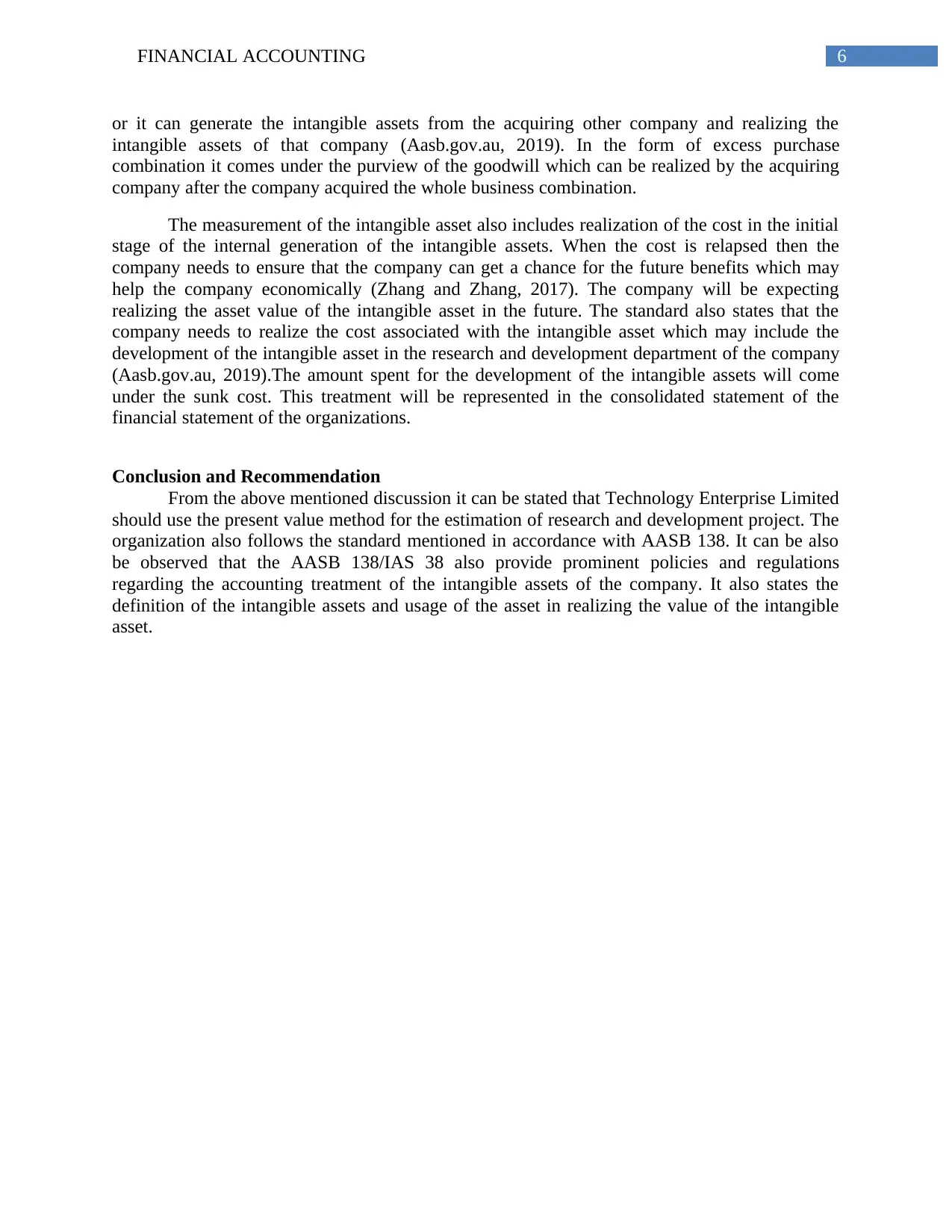
6FINANCIAL ACCOUNTING
or it can generate the intangible assets from the acquiring other company and realizing the
intangible assets of that company (Aasb.gov.au, 2019). In the form of excess purchase
combination it comes under the purview of the goodwill which can be realized by the acquiring
company after the company acquired the whole business combination.
The measurement of the intangible asset also includes realization of the cost in the initial
stage of the internal generation of the intangible assets. When the cost is relapsed then the
company needs to ensure that the company can get a chance for the future benefits which may
help the company economically (Zhang and Zhang, 2017). The company will be expecting
realizing the asset value of the intangible asset in the future. The standard also states that the
company needs to realize the cost associated with the intangible asset which may include the
development of the intangible asset in the research and development department of the company
(Aasb.gov.au, 2019).The amount spent for the development of the intangible assets will come
under the sunk cost. This treatment will be represented in the consolidated statement of the
financial statement of the organizations.
Conclusion and Recommendation
From the above mentioned discussion it can be stated that Technology Enterprise Limited
should use the present value method for the estimation of research and development project. The
organization also follows the standard mentioned in accordance with AASB 138. It can be also
be observed that the AASB 138/IAS 38 also provide prominent policies and regulations
regarding the accounting treatment of the intangible assets of the company. It also states the
definition of the intangible assets and usage of the asset in realizing the value of the intangible
asset.
or it can generate the intangible assets from the acquiring other company and realizing the
intangible assets of that company (Aasb.gov.au, 2019). In the form of excess purchase
combination it comes under the purview of the goodwill which can be realized by the acquiring
company after the company acquired the whole business combination.
The measurement of the intangible asset also includes realization of the cost in the initial
stage of the internal generation of the intangible assets. When the cost is relapsed then the
company needs to ensure that the company can get a chance for the future benefits which may
help the company economically (Zhang and Zhang, 2017). The company will be expecting
realizing the asset value of the intangible asset in the future. The standard also states that the
company needs to realize the cost associated with the intangible asset which may include the
development of the intangible asset in the research and development department of the company
(Aasb.gov.au, 2019).The amount spent for the development of the intangible assets will come
under the sunk cost. This treatment will be represented in the consolidated statement of the
financial statement of the organizations.
Conclusion and Recommendation
From the above mentioned discussion it can be stated that Technology Enterprise Limited
should use the present value method for the estimation of research and development project. The
organization also follows the standard mentioned in accordance with AASB 138. It can be also
be observed that the AASB 138/IAS 38 also provide prominent policies and regulations
regarding the accounting treatment of the intangible assets of the company. It also states the
definition of the intangible assets and usage of the asset in realizing the value of the intangible
asset.
Paraphrase This Document
Need a fresh take? Get an instant paraphrase of this document with our AI Paraphraser
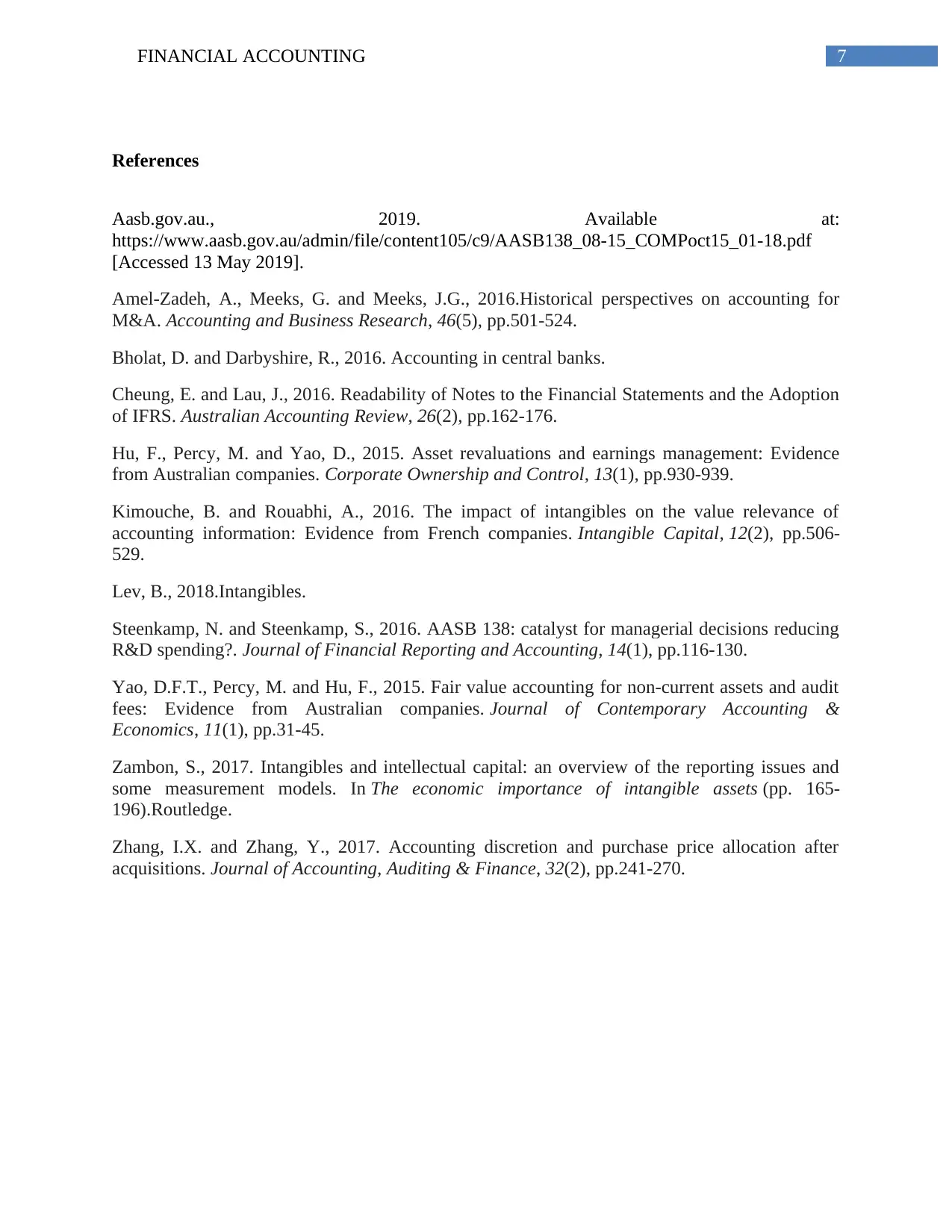
7FINANCIAL ACCOUNTING
References
Aasb.gov.au., 2019. Available at:
https://www.aasb.gov.au/admin/file/content105/c9/AASB138_08-15_COMPoct15_01-18.pdf
[Accessed 13 May 2019].
Amel-Zadeh, A., Meeks, G. and Meeks, J.G., 2016.Historical perspectives on accounting for
M&A. Accounting and Business Research, 46(5), pp.501-524.
Bholat, D. and Darbyshire, R., 2016. Accounting in central banks.
Cheung, E. and Lau, J., 2016. Readability of Notes to the Financial Statements and the Adoption
of IFRS. Australian Accounting Review, 26(2), pp.162-176.
Hu, F., Percy, M. and Yao, D., 2015. Asset revaluations and earnings management: Evidence
from Australian companies. Corporate Ownership and Control, 13(1), pp.930-939.
Kimouche, B. and Rouabhi, A., 2016. The impact of intangibles on the value relevance of
accounting information: Evidence from French companies. Intangible Capital, 12(2), pp.506-
529.
Lev, B., 2018.Intangibles.
Steenkamp, N. and Steenkamp, S., 2016. AASB 138: catalyst for managerial decisions reducing
R&D spending?. Journal of Financial Reporting and Accounting, 14(1), pp.116-130.
Yao, D.F.T., Percy, M. and Hu, F., 2015. Fair value accounting for non-current assets and audit
fees: Evidence from Australian companies. Journal of Contemporary Accounting &
Economics, 11(1), pp.31-45.
Zambon, S., 2017. Intangibles and intellectual capital: an overview of the reporting issues and
some measurement models. In The economic importance of intangible assets (pp. 165-
196).Routledge.
Zhang, I.X. and Zhang, Y., 2017. Accounting discretion and purchase price allocation after
acquisitions. Journal of Accounting, Auditing & Finance, 32(2), pp.241-270.
References
Aasb.gov.au., 2019. Available at:
https://www.aasb.gov.au/admin/file/content105/c9/AASB138_08-15_COMPoct15_01-18.pdf
[Accessed 13 May 2019].
Amel-Zadeh, A., Meeks, G. and Meeks, J.G., 2016.Historical perspectives on accounting for
M&A. Accounting and Business Research, 46(5), pp.501-524.
Bholat, D. and Darbyshire, R., 2016. Accounting in central banks.
Cheung, E. and Lau, J., 2016. Readability of Notes to the Financial Statements and the Adoption
of IFRS. Australian Accounting Review, 26(2), pp.162-176.
Hu, F., Percy, M. and Yao, D., 2015. Asset revaluations and earnings management: Evidence
from Australian companies. Corporate Ownership and Control, 13(1), pp.930-939.
Kimouche, B. and Rouabhi, A., 2016. The impact of intangibles on the value relevance of
accounting information: Evidence from French companies. Intangible Capital, 12(2), pp.506-
529.
Lev, B., 2018.Intangibles.
Steenkamp, N. and Steenkamp, S., 2016. AASB 138: catalyst for managerial decisions reducing
R&D spending?. Journal of Financial Reporting and Accounting, 14(1), pp.116-130.
Yao, D.F.T., Percy, M. and Hu, F., 2015. Fair value accounting for non-current assets and audit
fees: Evidence from Australian companies. Journal of Contemporary Accounting &
Economics, 11(1), pp.31-45.
Zambon, S., 2017. Intangibles and intellectual capital: an overview of the reporting issues and
some measurement models. In The economic importance of intangible assets (pp. 165-
196).Routledge.
Zhang, I.X. and Zhang, Y., 2017. Accounting discretion and purchase price allocation after
acquisitions. Journal of Accounting, Auditing & Finance, 32(2), pp.241-270.
1 out of 8
Related Documents
Your All-in-One AI-Powered Toolkit for Academic Success.
+13062052269
info@desklib.com
Available 24*7 on WhatsApp / Email
![[object Object]](/_next/static/media/star-bottom.7253800d.svg)
Unlock your academic potential
Copyright © 2020–2025 A2Z Services. All Rights Reserved. Developed and managed by ZUCOL.





